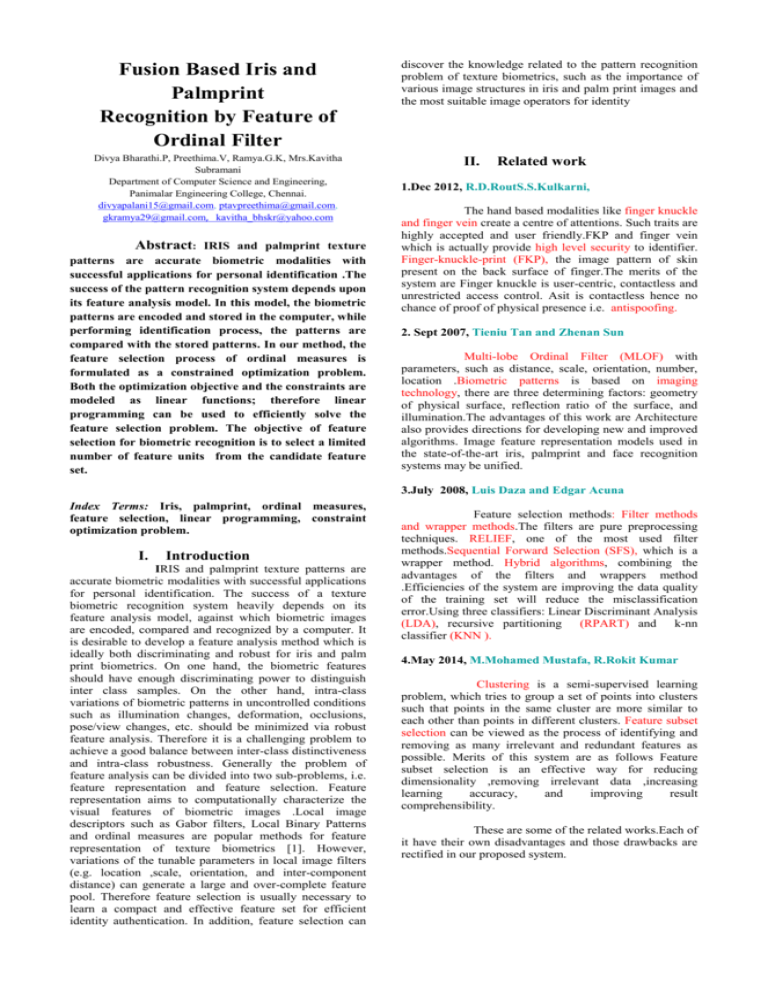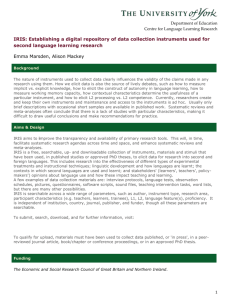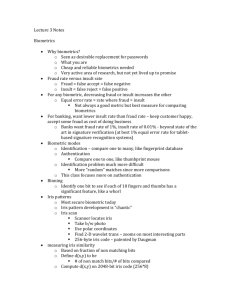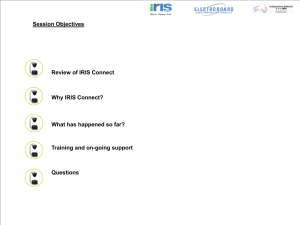Iris, palmprint, ordinal measures, feature selection, linear
advertisement

Fusion Based Iris and Palmprint Recognition by Feature of Ordinal Filter Divya Bharathi.P, Preethima.V, Ramya.G.K, Mrs.Kavitha Subramani Department of Computer Science and Engineering, Panimalar Engineering College, Chennai. divyapalani15@gmail.com, ptavpreethima@gmail.com, gkramya29@gmail.com, kavitha_bhskr@yahoo.com Abstract: IRIS and palmprint texture patterns are accurate biometric modalities with successful applications for personal identification .The success of the pattern recognition system depends upon its feature analysis model. In this model, the biometric patterns are encoded and stored in the computer, while performing identification process, the patterns are compared with the stored patterns. In our method, the feature selection process of ordinal measures is formulated as a constrained optimization problem. Both the optimization objective and the constraints are modeled as linear functions; therefore linear programming can be used to efficiently solve the feature selection problem. The objective of feature selection for biometric recognition is to select a limited number of feature units from the candidate feature set. discover the knowledge related to the pattern recognition problem of texture biometrics, such as the importance of various image structures in iris and palm print images and the most suitable image operators for identity II. Related work 1.Dec 2012, R.D.RoutS.S.Kulkarni, The hand based modalities like finger knuckle and finger vein create a centre of attentions. Such traits are highly accepted and user friendly.FKP and finger vein which is actually provide high level security to identifier. Finger-knuckle-print (FKP), the image pattern of skin present on the back surface of finger.The merits of the system are Finger knuckle is user-centric, contactless and unrestricted access control. Asit is contactless hence no chance of proof of physical presence i.e. antispoofing. 2. Sept 2007, Tieniu Tan and Zhenan Sun Multi-lobe Ordinal Filter (MLOF) with parameters, such as distance, scale, orientation, number, location .Biometric patterns is based on imaging technology, there are three determining factors: geometry of physical surface, reflection ratio of the surface, and illumination.The advantages of this work are Architecture also provides directions for developing new and improved algorithms. Image feature representation models used in the state-of-the-art iris, palmprint and face recognition systems may be unified. 3.July 2008, Luis Daza and Edgar Acuna Index Terms: Iris, palmprint, ordinal measures, feature selection, linear programming, constraint optimization problem. I. Introduction IRIS and palmprint texture patterns are accurate biometric modalities with successful applications for personal identification. The success of a texture biometric recognition system heavily depends on its feature analysis model, against which biometric images are encoded, compared and recognized by a computer. It is desirable to develop a feature analysis method which is ideally both discriminating and robust for iris and palm print biometrics. On one hand, the biometric features should have enough discriminating power to distinguish inter class samples. On the other hand, intra-class variations of biometric patterns in uncontrolled conditions such as illumination changes, deformation, occlusions, pose/view changes, etc. should be minimized via robust feature analysis. Therefore it is a challenging problem to achieve a good balance between inter-class distinctiveness and intra-class robustness. Generally the problem of feature analysis can be divided into two sub-problems, i.e. feature representation and feature selection. Feature representation aims to computationally characterize the visual features of biometric images .Local image descriptors such as Gabor filters, Local Binary Patterns and ordinal measures are popular methods for feature representation of texture biometrics [1]. However, variations of the tunable parameters in local image filters (e.g. location ,scale, orientation, and inter-component distance) can generate a large and over-complete feature pool. Therefore feature selection is usually necessary to learn a compact and effective feature set for efficient identity authentication. In addition, feature selection can Feature selection methods: Filter methods and wrapper methods.The filters are pure preprocessing techniques. RELIEF, one of the most used filter methods.Sequential Forward Selection (SFS), which is a wrapper method. Hybrid algorithms, combining the advantages of the filters and wrappers method .Efficiencies of the system are improving the data quality of the training set will reduce the misclassification error.Using three classifiers: Linear Discriminant Analysis (LDA), recursive partitioning (RPART) and k-nn classifier (KNN ). 4.May 2014, M.Mohamed Mustafa, R.Rokit Kumar Clustering is a semi-supervised learning problem, which tries to group a set of points into clusters such that points in the same cluster are more similar to each other than points in different clusters. Feature subset selection can be viewed as the process of identifying and removing as many irrelevant and redundant features as possible. Merits of this system are as follows Feature subset selection is an effective way for reducing dimensionality ,removing irrelevant data ,increasing learning accuracy, and improving result comprehensibility. These are some of the related works.Each of it have their own disadvantages and those drawbacks are rectified in our proposed system. PALM PRINT FEATURE EXTRACTION linear inequality constraints of LP optimization problem require that all intra- and inter-class matching results are well separated from each other with a large margin. Slack variables are introduced to ensure the inequality constraints of ambiguous and outlier samples. III. IRIS FEATURE EXTRACTION In summary, both Boosting[14],[16] and Lasso[15],[16] have limitations in ordinal feature selection .The feature selection problem has less dependence on the training data and it can be solved by a small set of training samples. It requires the feature selection method can circumvent the curse of dimensionality problem and generalize to practical applications. The objective function of our LP formulation includes two parts. The first part measures the misclassification errors of training samples failing to follow a large margin principle. And the second part indicates weighted sparsity of ordinal feature units. Traditional sparse representation uses L1-norm to achieve sparsity of feature selection and all feature components have an identical unit weight in sparse learning. However, we argue that it is better to incorporate some prior information related to candidate feature units into sparse representation so that the most individually accurate ordinal measures are given preferential treatment. And the Proposed work In our method, the feature selection process of ordinal measures is formulated as a constrained optimization problem. Both the optimization objective and the constraints are modeled as linear functions; therefore linear programming can be used to efficiently solve the feature selection problem. The objective of feature selection for biometric recognition is to select a limited number of feature units from the candidate feature set. In this paper, a feature unit is defined as the regional ordinal encoding result using a specific ordinal filter on a specific biometric region. We aim to use a machine learning technique to find the weights of all ordinal feature units. So that feature selection can also be regarded as a sparse representation method, i.e. most weight values are zero and only a compact set of feature units have the weighted contribution to biometric recognition. This paper mainly focuses on feature analysis of palm print biometrics. To test the proposed feature selection method for palm print recognition, the PolyU palm print image database is used for performance evaluation. In our method, the feature selection process of ordinal measures is formulated as a constrained optimization problem. Both the optimization objective and the constraints are modeled as linear functions; therefore linear programming can be used to efficiently solve the feature selection problem. These methods employ different optimization functions and searching strategies for feature selection. For example, the criteria of Max-Dependency, Max-Relevance is used to formulate an optimization based feature selection method mRMR [11]. ReliefF is a simple yet efficient feature selection method suitable for problems with strong dependencies between features [12]. ReliefF has been regarded as one of the most successful strategies in feature selection because the key idea of the ReliefF is to estimate the quality of features according to how well their values distinguish between instances that are near to each other. Most research works on feature selection mainly focus on generic pattern classification applications rather than specific applications in biometrics. This paper mainly addresses the efficient feature selection methods applicable to biometric authentication. Boosting[14],[16]and Lasso[15],[16] have been proved as the well performed feature selection methods in face recognition. The basic idea of the proposed feature selection method is to find a sparse representation of ordinal features on the condition of large margin principle. On one hand, the intra-and inter-class biometric matching results are expected to be well separated with a large margin. On the other hand, the number of selected ordinal features should be much smaller than the large number of candidates. These two seemingly contradictory requirements are well integrated in our feature selection method. The feature selection method proposed in this paper has a different optimization formulation to the existing LP method [13] in terms of the weighted sparsity term in objective function and nonnegative constraint of feature weights. Therefore our method is more suitable to learn discriminant, robust and sparse features for biometric recognition. It should be noted that our LP formulation is flexible and a number of variants may be generated to meet the requirements of some specific feature selection applications.. If these newly added terms can be expressed in linear functions, our feature selection can also be efficiently solved based on linear programming. The following two sections will demonstrate the effectiveness of the proposed feature selection method for iris and palmprint recognition respectively. State-of-the-art iris and palmprint recognition methods and representative feature selection methods are evaluated on the CASIA and PolyU biometrics databases for performance comparison to show the merit of the proposed LP formulation. It should be noted that the main purpose of this paper is to discover the most effective ordinal features for iris and palmprint recognition. It can be regarded as a specific feature selection problem.. And two representative methods in generic feature selection, i.e. mRMR [11] and ReliefF [12], and two popular feature selection methods in biometrics, i.e. Boosting [14] and Lasso [15], [17], are used for performance comparison. IV. Fused recognition process Some typical ordinal feature units which are selected by mRMR, LP, Lasso and Boost are illustrated(Theresults of ReliefF are not shown here because it performsmuch worse than other feature selection methods). A number of conclusions can be drawn from the visualization of feature selection results. 1) The lower part of iris image regions adjacent to pupil are the most effective for iris recognition because these regions are rich of iris texture information and have much smaller probability to be occluded by eyelids and eyelashes. 2) Both di-lobe and tri-lobe filters are selected so they are complementary for iris recognition. And the orientation of most ordinal filters is horizontal because iris texture is mainly distributed along the circular direction in iris images, i.e. horizontal orientation in the normalized format. 3) There exist some differences among the four feature selection methods (mRMR, LP, Lasso and Boost) in terms of the selected ordinal filters and iris image regions. And these minor differences of feature selection results determine the differences of iris recognition performance. Ordinal features are effective for iris recognition. Even though we randomly select 15 ordinal feature units from 47,016 candidates, it is possible to achieve a good recognition performance (EER=2.91%) on the largest iris dataset in the public domain. The ordinal features automatically selected by most machine learning approaches (Boost-OM, Lasso-OM, mRMR-OM and LP-OM) perform much better than randomly chosen ordinal features (Random-OM). Therefore it is necessary to adopt feature selection methods to learn a distinctive and robust ordinal feature set for iris recognition. The feature selection based iris recognition methods perform significantly better than state-of-the-art methods[26], [27]. There are two advantages of our methods. The first is the advantage of ordinal measures [3] over iris code [26] and shape code [27]. The second advantage is the use of feature selection method. In contrast, the implementation of state-of-the- art iris recognition methods is based on hand-crafted feature parameters. To demonstrate the effectiveness of the proposed feature selection method, LP is also used to select the best parameter setting of Gabor filters for irisrecognition in Appendix A [37]. The results show that learned Gabor filters can achieve much higher accuracy the Gabor filters of the hand-crafted feature parameters. There exist performance differences between the five feature selection methods. Both mRMR-OM and ReliefF-OM are generic feature selection methods, which are worse than the proven feature selection methods inbiometrics such as Boost-OM and Lasso-OM. In general,the global optimization methods such as Lasso-OM andLP-OM can achieve a higher accuracy in testing dataset than greedy learning method such as Boost-OM. AndLP-OM can learn a better ordinal feature set than LassoOM. Palm Pre-Processing V. Methodologies used Iris detection The part of the eye carrying information is only the iris part. It lies between the sclera and the pupil. Hence the next step is separating the iris part from the eye image. The iris inner and outer boundaries are located by finding the edge image using the eigen values. It should be noted that the process of ordinal feature selection does not consider the prior mask information of eyelids,eyelashes, specular reflections. There are mainly two kinds of strategies to deal with occlusion problem in iris recognition. The first is to segment and exclude occlusion regions in iris images and label the regions using mask in iris matching. But it needs accurate and efficient iris segmentation. In addition ,the size of iris template becomes double. More importantly, the computational cost of both iris image preprocessing and iris matching is significantly increased because of the iris mask strategy. So it is more realistic to identify and exclude the heavily occluded iris images in quality assessment stage. The remained iris images used for feature extraction and matching are less occluded by eyelids and eyelashes. So that it is beneficial to both accuracy and efficiency of iris recognition. This paper aims to learn a common ordinal feature set applicable to less occluded iris images of all subjects. The iris images of the first 25 subjects are used as the training dataset and the remained 19,500 iris images of 975subjects are used to test the performance of various feature selection methods. There are totally 500 iris images of50 eyes in the training dataset and they are used to generate2,250 intra-class and 4,900 inter-class matching samples. We do not use all possible inter-class matching samples due to three reasons. Firstly, it can keep the balance between the number of positive and negative samples. Secondly, the use ofa subset of inter-class comparisons can minimize the number of linear constraints in linear programming so that the solution of optimization problem is simplified. Thirdly, it can reduce the redundancy among negative samples. Five iris recognition methods namely LP-OM, Boost-OM, LassoOM, mRMR-OM and ReliefF-OM are performed on the training dataset to obtain the most effective feature set of ordinal measures respectively. A method to enhance the contrast of digital image using a modified histogram equalization technique was proposed. The algorithm called AHE calculates the amount of enhancement needed depending on the shape of the histogram . Palm print provides a reliable source of information for automatic personal identification and has wide and important applications [29], [30]. Richness of visual information available on palm print images including principal lines, wrinkles, ridges, minutiae points, singular points, texture, etc. provides various possibilities for palm print feature representation and pattern recognition [29], [30]. A number of feature representation methods for palm print recognition have been proposed in the literature ,including geometric structure such as point and line patterns, global appearance description based on subspace analysis, and local texture analysis, etc. Competitive code represents the state-of-the-art performance in palm print recognition[29]–[31]. There, each palm print image region is assumed to have a dominant line segment and its orientation is regarded as the palm print feature. Because the even Gabor filter is well suited to model the line segment, it was used to filter the local image region along six different orientations, obtaining the corresponding contrast magnitudes. Based on the winner take-all competitive rule, the index (ranging from 0 to 5) of the minimum contrast magnitude was represented by three bits, namely competitive code [31]. Recently some improvements[32], [33] or variants [34] of competitive code have been reported. This paper attempts to provide a new understanding and solution to the problem of palm print feature analysis using ordinal measures and linear programming. Unique and rich texture information of palm print images is useful for personal identification. There are a large number of irregularly distributed line segments on palm surface, mainly constituted by principle lines and wrinkles. Photometric properties of these line segments are significantly different to that of non-line regions. Thus the reflection ratios between line and nonline regions have stable ordinal relationship, i.e. R(line) < R(non − line). PCA Fusion & RECOGNITION Principal Component Analysis algorithm builds a fused feature of input palm prints and Iris as a weighted of all features. The classifier based on the Euclidean distance has been used which is obtained by calculating the distance between the image which are to be tested and the already available images used as the training images. Then the minimum distance is observed from the set of values. Because of the difference between the texture primitive in iris and palm print biometric patterns, we need to provide biometric modality specific ordinal filters as the input of feature selection. VI. Conclusion This paper has proposed a novel feature selection method to learn the most effective ordinal features for iris and palm print recognition based on linear programming. The success of LP feature selection comes from the incorporation of the large margin principle and weighted sparsity rules into the LP formulation. The feature selection model based on LP Is flexible to integrate the prior information of each feature unit related to biometric recognition such as DI, EER and AUC into the optimization procedure. The experimental results have demonstrated that the proposed LP feature selection method outperforms mRMR, ReliefF, Boosting and Lasso. A number of conclusions can be drawn from the study. • The identity information of visual biometric patterns comes from the unique structure of ordinal measures. The optimal setting of parameters in local ordinal descriptors varies from biometric modality to modality, subject to subject and even region to region. So it is impossible to develop a common set of ordinal filters to achieve the best performance for all visual biometric patterns. Ideally it is better to select the optimal ordinal filters to encode individually specific ordinal measures via machine learning. However, such a personalized solution is in efficient in large-scale personal identification applications. So the task of this paper turns to a suboptimal solution ,learning a common ordinal feature set for each biometric modality, which is expected to work well for most subjects. • A main contribution of this paper is a novel optimization formulation for feature selection based on linear programming(LP). Our expectations on the feature selection results, i.e. an accurate and sparse ordinal feature set, can be described as a linear objective function. Such a linear learning model has three advantages. Firstly ,it is simple to build, understand, learn and explain the feature selection model. Secondly, linear penalty term is robust against outliers. Thirdly, linear model only needs a small number of training samples to achieve a global optimization result with great generalization ability. VII. References [1] A. K. Jain, A. A. Ross, and K. Nandakumar, Introduction to Biometrics. New York, NY, USA: Springer-Verlag, 2011. [2] T. Tan and Z. Sun, “Ordinal representations for biometrics recognition,” in Proc. 15th Eur. Signal Process. Conf., 2007, pp. 35–39. [3] Z. Sun and T. Tan, “Ordinal measures for iris recognition,” IEEE Trans. Pattern Anal. Mach. Intell., vol. 31, no. 12, pp. 2211– 2226, Dec. 2009. [4] Z. Sun, T. Tan, Y. Wang, and S. Z. Li, “Ordinal palmprint representation for personal identification,” in Proc. Conf. Comput. Vis. Pattern Recognit. (CVPR), vol. 1. 2005, pp. 279–284. [5] Z. Chai, Z. Sun, H. Mendez-Vazquez, R. He, and T. Tan, “Gabor ordinal measures for face recognition,” IEEE Trans. Inf. Forensics Security, vol. 9, no. 1, pp. 14–26, Jan. 2014. [6] H. Liu and L. Yu, “Toward integrating feature selection algorithms for classification and clustering,” IEEE Trans. Knowl. Data Eng., vol. 17, no. 4, pp. 491–502, Apr. 2005. [7] L. Yu and H. Liu, “Efficient feature selection via analysis of relevance and redundancy,” J. Mach. Learn. Res., vol. 5, pp. 1205– 1224, Oct. 2004. [8] M. A. Hall, “Correlation-based feature selection for discrete and numeric class machine learning,” in Proc. 17th Int. Conf. Mach. Learn., 2000, pp. 359–366. [9] S. Das, “Filters, wrappers and a boosting-based hybrid for feature selection,” in Proc. 18th Int. Conf. Mach. Learn., 2001, pp. 74–81. [10] Q. Song, J. Ni, and G. Wang, “A fast clusteringbased feature subset selection algorithm for high-dimensional data,” IEEE Trans. Knowl. Data Eng., vol. 25, no. 1, pp. 1–14, Jan. 2013. [11] H. Peng, F. Long, and C. Ding, “Feature selection based on mutual information criteria of max-dependency, max-relevance, and minredundancy,” IEEE Trans. Pattern Anal. Mach. Intell., vol. 27, no. 8, pp. 1226–1238, Aug. 2005. [12] R.-S. Marko and K. Igor, “Theoretical and empirical analysis of ReliefF and RReliefF,” Mach. Learn. J., vol. 53, nos. 1–2, pp. 23– 69, 2003. [13] G. Guo and C. R. Dyer, “Simultaneous feature selection and classifier training via linear programming: a case study for face expression recognition,” in Proc. Conf. Comput. Vis. Pattern Recognit. (CVPR), Jun. 2003, pp. 346–352. [14] P. Viola and M. Jones, “Robust real-time face detection,” Int. J. Comput. Vis., vol. 57, no. 2, pp. 137–154, May 2004. [15] A. Destrero, C. De Mol, F. Odone, and A. Verri, “A regularized framework for feature selection in face detection and authentication,” Int. J. Comput. Vis., vol. 83, no. 2, pp. 164–177, Jun. 2009. [16] S. Z. Li, R. Chu, S. Liao, and L. Zhang, “Illumination invariant face recognition using near-infrared images,” IEEE Trans. Pattern Anal. Mach. Intell., vol. 29, no. 4, pp. 627–639, Apr. 2007. [17] A. Destrero, C. De Mol, F. Odone, and A. Verri, “A sparsity-enforcing method for learning face features,” IEEE Trans. Image Process., vol. 18, no. 1, pp. 188–201, Jan. 2009. [18] L. Wang, Z. Sun, and T. Tan, “Robust regularized feature selection for iris recognition via linear programming,” in Proc. 21st Int. Conf. Pattern Recognit. (ICPR), Nov. 2012, pp. 3358–3361. [19] (2014, May 23). CPLEX [Online]. Available: http://www.ibm.com [20] (2014, May 23). LINDO [Online]. Available: http://www.lindo.com [21] S. Boyd and L. Vandenberghe, Convex Optimization. Cambridge, U.K.: Cambridge Univ. Press, 2004. [22] J. Friedman, T. Hastie, and R. Tibshirani, “Additive logistic regression: A statistical view of boosting,” Ann. Statist., vol. 28, no. 2, pp. 337–407, 2000. [23] I. Daubechies, M. Defrise, and C. De Mol, “An iterative thresholding algorithm for linear inverse problems with a sparsity constraint,” Commun. Pure Appl. Mathem., vol. 57, no. 11, pp. 1413–1457, Nov. 2004. [24] Z. He, T. Tan, Z. Sun, and X. Qiu, “Toward accurate and fast iris segmentation for iris biometrics,” IEEE Trans. Pattern Anal. Mach. Intell., vol. 31, no. 9, pp. 1670–1684, Sep. 2009. [25] (2014, May 23). CASIA Iris Image Database [Online]. Available: http://biometrics.idealtest.org [26] J. G. Daugman, “High confidence visual recognition of persons by a test of statistical independence,” IEEE Trans. Pattern Anal. Mach. Intell., vol. 15, no. 11, pp. 1148–1161, Nov. 1993. [27] L. Ma, T. Tan, Y. Wang, and D. Zhang, “Efficient iris recognition by characterizing key local variations,” IEEE Trans. Image Process., vol. 13, no. 6, pp. 739–750, Jun. 2004. [28] A. Kumar, T.-S. Chan, and C.-W. Tan, “Human identification from at-adistance face images using sparse representation of local iris features,” in Proc. 5th Int. Conf. Pattern Recognit. (IAPR) Int. Conf. Biometrics (ICB), Mar./Apr. 2012, pp. 303–309. [29] D. Zhang, W. Zuo, and F. Yue, “A comparative study of palmprint recognition algorithms,” ACM Comput. Surveys, vol. 44, no. 1, p. 2, Jan. 2012. [30] A. Kong, D. Zhang, and M. Kamel, “A survey of palmprint recognition,” J. Pattern Recognit., vol. 42, no. 7, pp. 1408–1418, 2009. [31] A. W.-K. Kong and D. Zhang, “Competitive coding scheme for palmprint verification,” in Proc. 17th Int. Conf. Pattern Recognit. (ICPR), vol. 1. Aug. 2004, pp. 520–523. [32] F. Yue, W. Zuo, D. Zhang, and K. Wang, “Orientation selection using modified FCM for competitive code-based palmprint recognition,” Pattern Recognit., vol. 42, no. 11, pp. 2841–2849, 2009. [33] W. Zuo, Z. Lin, Z. Guo, and D. Zhang, “The multiscale competitive code via sparse representation for palmprint verification,” in Proc. IEEE Conf. Comput. Vis. Pattern Recognit. (CVPR), Jun. 2010, pp. 2265–2272. [34] W. Jia, D.-S. Huang, and D. Zhang, “Palmprint verification based on robust line orientation code,” Pattern Recognit., vol. 41, no. 5, pp. 1504–1513, May 2008. [35] (2014, May 23). PolyU Palmprint Database [Online]. Available: http://www.comp.polyu.edu.hk/∼biometrics/ [36] (2014, May 23). CASIA Palmprint Database [Online]. Available: http://biometrics.idealtest.org [37] (2014, May 23). Appendix of this Paper [Online]. Available: http://www.cripac.ia.ac.cn/people/znsu n/TIP-LPOM.pdf







